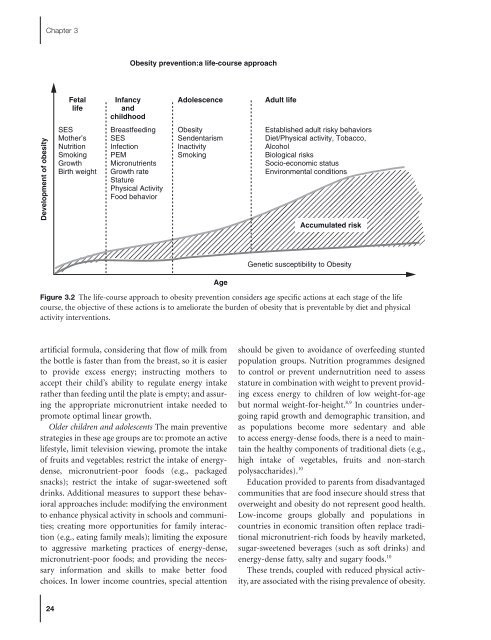Preventing Childhood Obesity - Evidence Policy and Practice.pdf
Preventing Childhood Obesity - Evidence Policy and Practice.pdf
Preventing Childhood Obesity - Evidence Policy and Practice.pdf
Create successful ePaper yourself
Turn your PDF publications into a flip-book with our unique Google optimized e-Paper software.
Chapter 3<br />
<strong>Obesity</strong> prevention:a life-course approach<br />
Fetal<br />
life<br />
Infancy<br />
<strong>and</strong><br />
childhood<br />
Adolescence<br />
Adult life<br />
Development of obesity<br />
SES<br />
Mother’s<br />
Nutrition<br />
Smoking<br />
Growth<br />
Birth weight<br />
Breastfeeding<br />
SES<br />
Infection<br />
PEM<br />
Micronutrients<br />
Growth rate<br />
Stature<br />
Physical Activity<br />
Food behavior<br />
<strong>Obesity</strong><br />
Sendentarism<br />
Inactivity<br />
Smoking<br />
Established adult risky behaviors<br />
Diet/Physical activity, Tobacco,<br />
Alcohol<br />
Biological risks<br />
Socio-economic status<br />
Environmental conditions<br />
Accumulated risk<br />
Genetic susceptibility to <strong>Obesity</strong><br />
Age<br />
Figure 3.2 The life - course approach to obesity prevention considers age specific actions at each stage of the life<br />
course, the objective of these actions is to ameliorate the burden of obesity that is preventable by diet <strong>and</strong> physical<br />
activity interventions.<br />
artificial formula, considering that flow of milk from<br />
the bottle is faster than from the breast, so it is easier<br />
to provide excess energy; instructing mothers to<br />
accept their child ’ s ability to regulate energy intake<br />
rather than feeding until the plate is empty; <strong>and</strong> assuring<br />
the appropriate micronutrient intake needed to<br />
promote optimal linear growth.<br />
Older children <strong>and</strong> adolescents The main preventive<br />
strategies in these age groups are to: promote an active<br />
lifestyle, limit television viewing, promote the intake<br />
of fruits <strong>and</strong> vegetables; restrict the intake of energy -<br />
dense, micronutrient - poor foods (e.g., packaged<br />
snacks); restrict the intake of sugar - sweetened soft<br />
drinks. Additional measures to support these behavioral<br />
approaches include: modifying the environment<br />
to enhance physical activity in schools <strong>and</strong> communities;<br />
creating more opportunities for family interaction<br />
(e.g., eating family meals); limiting the exposure<br />
to aggressive marketing practices of energy - dense,<br />
micronutrient - poor foods; <strong>and</strong> providing the necessary<br />
information <strong>and</strong> skills to make better food<br />
choices. In lower income countries, special attention<br />
should be given to avoidance of overfeeding stunted<br />
population groups. Nutrition programmes designed<br />
to control or prevent undernutrition need to assess<br />
stature in combination with weight to prevent providing<br />
excess energy to children of low weight - for - age<br />
but normal weight-for-height.8,9 In countries undergoing<br />
rapid growth <strong>and</strong> demographic transition, <strong>and</strong><br />
as populations become more sedentary <strong>and</strong> able<br />
to access energy - dense foods, there is a need to maintain<br />
the healthy components of traditional diets (e.g.,<br />
high intake of vegetables, fruits <strong>and</strong> non - starch<br />
polysaccharides).10<br />
Education provided to parents from disadvantaged<br />
communities that are food insecure should stress that<br />
overweight <strong>and</strong> obesity do not represent good health.<br />
Low - income groups globally <strong>and</strong> populations in<br />
countries in economic transition often replace traditional<br />
micronutrient - rich foods by heavily marketed,<br />
sugar - sweetened beverages (such as soft drinks) <strong>and</strong><br />
energy - dense fatty, salty <strong>and</strong> sugary foods. 10<br />
These trends, coupled with reduced physical activity,<br />
are associated with the rising prevalence of obesity.<br />
24

















